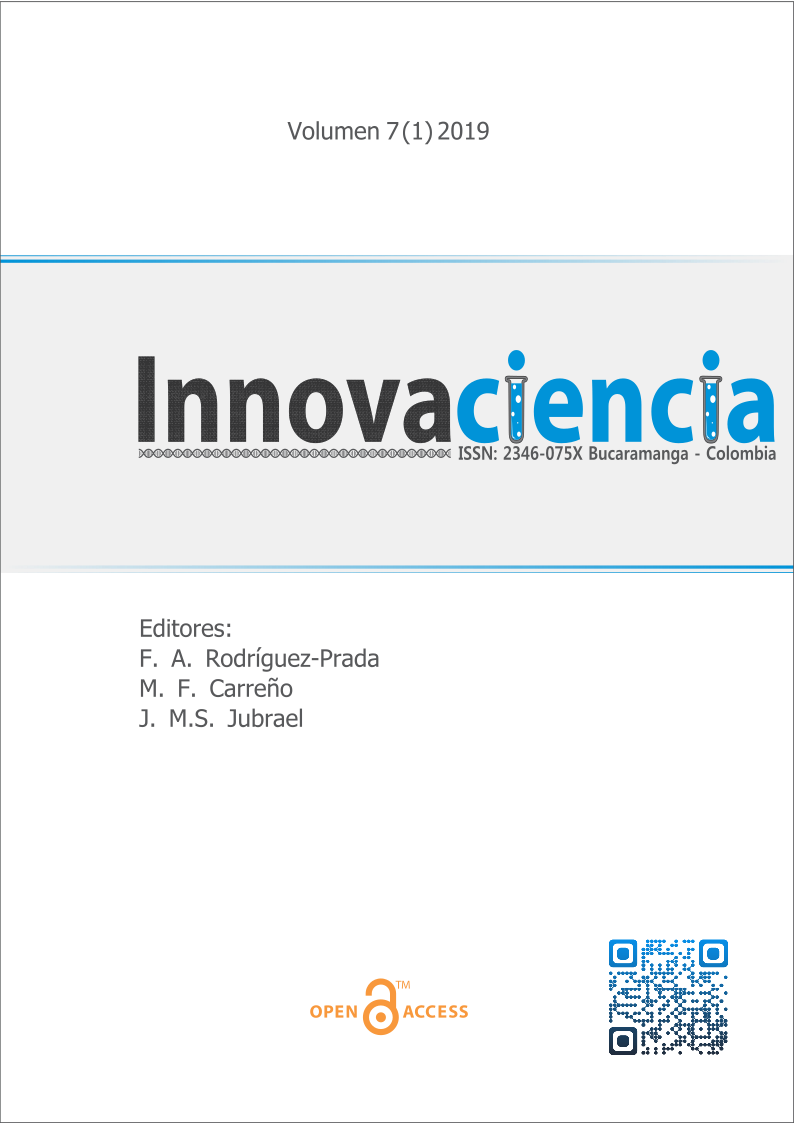Actividad antifúngica de algunos extractos de plantas medicinales contra algunos aislados de hongos.
DOI:
https://doi.org/10.15649/2346075X.506Palabras clave:
Plant extracts; fungal isolates; Antifungal activity.Resumen
Introduction: Fungi live everywhere in the environment, most of them are not dangerous, but some types of fungi can be harmful to human
health. The medicinal plants contain many antimicrobial components that make them recently used as powerful drugs. The aim of the present investigation was to examine the antifungal potential and minimum inhibitory concentration (MIC) of three plant extract: Aloe vera gel, cinnamon (Cinnamomum zeylanicum) and turmeric (Curcuma longa) against three fungal species: Aspergillus niger, Candida albicans and Fusarium oxysporum. Materials and Methods: The plant materials were extracted using solvents DMSO and ethanol and then were tested against the selected fungal isolates using well diffusion method. Results and Discussion: Antifungal activity of Aloe vera against Aspergillus niger showed MIC value of 25% whereas for Candida albicans and Fusarium oxysporum the MIC obtained was 100%. Both cinnamon and turmeric showed maximum potency against Aspergillus niger, Candida albicans and Fusarium oxysporum at highest MIC value of 100 %. The degree of inhibition increased correspondingly with increasing concentrations of the plant extracts. Conclusions: the tested plant extracts have an antifungal activity and could be used as alternative drugs.
Referencias
Hadacek, F. Secondary Metabolites as Plant Traits: Current Assessment and Future Perspectives. Crit. Rev. Plant Sci. 2002; 21(4): 273-322. https://doi.org/10.1080/0735-260291044269
Rawal, P. and Adhikari R. S. Evaluation of antifungal activity of Zingiber officinale against Fusarium oxysporum f. sp. lycopersici. 2016; 7(2):5-9.
Uniyal, S.K., Singh, K.N., Jamwal, P. and Lal, B. Traditional use of medicinal plants among the tribal communities of Chhota Bhangal, Western Himalayan. J. Ethnobiol. Ethnomed. 2006; 2: 1-14. https://doi.org/10.1186/1746-4269-2-14
Mahesh, 1.B. and Satish, S. Antimicrobial Activity of Some Important Medicinal Plant against Plant and Human Pathogens. World Journal of Agricultural Sciences. 2008; 4: 839-843.
Hawksworth, D.L. The magnitude of fungal diversity: the 1.5 million species estimate revisited. Mycol. Res. 2001; 105:1422-1432. https://doi.org/10.1017/S0953756201004725
Garcia-Solache, M.A., and Casadevall, A. Global warming will bring new fungal diseases for mammals. M.Bio. 2010; 1(1): 1-3. https://doi.org/10.1128/mBio.00061-10
Saddiq, A A N. Antiagnostic effect of musk and sidr leaves on some of the opportunistic fungi that cause Lung toxicity. Life Science Journal. 2014; 11(2s):99-108.
Evan's, W.C. Trease and Evan's pharmacognosy. 14th Edn., W.B. Saunders Company Ltd, London. 1999.
Davis, J. Inactivation of antibiotics and the dissemination of resistance genes. Science. 1994; 264: 375-382. https://doi.org/10.1126/science.8153624
Hassawi, D. and Kharma, A. Antimicrobial activity of some medicinal plants against Candida albicans. J. Biol. Sci. 2006; 6(1):109-114. https://doi.org/10.3923/jbs.2006.109.114
AL-Jobori K. M. M., AL- Ameed A. I., Witwit N.M. In vitro Antifungal Activity of Musk. BEPLS. 2015; 4(11): 38-44.
Pugh, N., Ross S. A., Elsohly, M. H. and Pasco D. S. Characterizations of Aloeride, new high molecular weight polysaccharides from Aloe vera with potent immunostimulatory activity. J Agri Food Chem. 2001; 49(2): 1030-1034. https://doi.org/10.1021/jf001036d
Banso, A. Phytochemical and antibacterial investigation of bark extracts of Acacia nilotica. Journal of Medicinal Plant Research. 2009; 3 (5): 82-85.
Magaldi, S., Mata-Essayag, S., Hartung de Capriles, C., Perez, C., Colella, M.T., Olaizola, C., and Ontiveros, Y. Well diffusion for antifungal susceptibility testing. Inter. J. Infec. Dis. 2004; 8:39-45. https://doi.org/10.1016/j.ijid.2003.03.002
Atherton, P. Aloe vera Myth or Medicine? Positive Health Publications, Denmark, Europe. 2002.
Coopoosamy, R.M and M.L. Magwa. Traditional use, antibacterial activity and antifungal activity of crude extract of Aloe excelsa. African Journal of Biotechnology 2007; 6(20): 2406-2410. https://doi.org/10.5897/AJB2007.000-2377
Arunkumar, S. and Muthuselvam, M. Analysis of phytochemical constituents and antimicrobial activities of Aloe vera L. against clinical pathgens. World Journal of Agricultural Sciences. 2009; 5(5): 572-576.
Azzouz, M. A. and Bullerman,L. R. Comparative antimycotic effects of selected herbs and spices, plant components and commercial antifungal agents. J. Food Protect. 1982; 45: 1248-1301. https://doi.org/10.4315/0362-028X-45.14.1298
Soliman, K.M. and Badea, R.I. Effect of oil extracted from some medicinal plants on different mycotoxigenic fungi. Food Chem Toxicol. 2002; 40: 1669-1675. https://doi.org/10.1016/S0278-6915(02)00120-5
Velluti, A. Sanchis, V. Ramos, A.J. Egido, J. and Marin, S. Inhibitory effect of cinnamon, clove, lemongrass, oregano and palmarose essential oils on growth and fumonisin B1 production by Fusarium proliferatum in maize grain. J. Food Microbiol. 2003; 89: 145-154. https://doi.org/10.1016/S0168-1605(03)00116-8
Singh, G. Maurya, S. DeLampasona, M.P. and Catalan, C.A. A comparison of chemical, antioxidant and antimicrobial studies of cinnamon leaf and bark volatile oils, oleoresins and their constituents. Food Chem. Toxicol. 2007; 45(9): 1650-1661. https://doi.org/10.1016/j.fct.2007.02.031
Matan, N., Rimkeeree, H. Mawson, A.J. Chompreeda,P. Haruthaithanasan, V., and Parker, M. Antimicrobial activity of cinnamon and clove oils under modified atmosphere conditions. J. Food Microbiol. 2006; 107: 180 - 185. https://doi.org/10.1016/j.ijfoodmicro.2005.07.007
Wang, S.Y., Chen P.F. and Chang, S.T. Antifungal activities of essential oils and their constituents from indigenous cinnamon (Cinnamomum osmophloeum) leaves against wood decay fungi Bioresour. Technol. 2005; 96: 813-818. https://doi.org/10.1016/j.biortech.2004.07.010
Bang, K.H. Lee, D.W. Park, H.M. and Rhee,Y.H. Inhibition of fungal cell wall synthesizing enzymes by transcinnamaldehyde. Biosci. Biotech. Biochem. 2000; 64: 1061-1063. https://doi.org/10.1271/bbb.64.1061
Dovigo,L. N. Pavarina, A. C. Carmello, J. C. MacHado, A. L. Brunetti, I.L. and Bagnato, V. S. Susceptibility of clinical isolates of Candida to photodynamic effects of curcumin. Lasers in Surgery and Medicine. 2011; 43(9): pp. 927-934. https://doi.org/10.1002/lsm.21110

Descargas
Publicado
Cómo citar
Descargas
Número
Sección
Licencia
Todos los artículos publicados en esta revista científica están protegidos por los derechos de autor. Los autores retienen los derechos de autor y conceden a la revista el derecho de primera publicación con el trabajo simultáneamente licenciado bajo una Licencia Creative Commons Atribución-NoComercial 4.0 Internacional (CC BY-NC 4.0) que permite compartir el trabajo con reconocimiento de autoría y sin fines comerciales.
Los lectores pueden copiar y distribuir el material de este número de la revista para fines no comerciales en cualquier medio, siempre que se cite el trabajo original y se den crédito a los autores y a la revista.
Cualquier uso comercial del material de esta revista está estrictamente prohibido sin el permiso por escrito del titular de los derechos de autor.
Para obtener más información sobre los derechos de autor de la revista y las políticas de acceso abierto, por favor visite nuestro sitio web.















